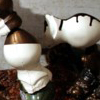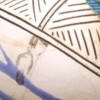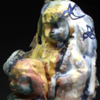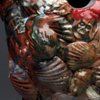ARTIST INFORMATION
| NAME: | Courtney M. Leonard | |
| NATION: | Shinnecock | |
| ADDRESS | PO Box 1551, Old Point Rd Shinnecock Indian Reservation, Southampton, NY 11969 | |
| TELEPHONE: | ||
| EMAIL: | courtney@courtneymleonard.com | |
| WEBSITE: | www.courtneymleonard.com | |
| DISCIPLINE: | Mixedmedia Artist | |
ARTIST BIO
Born in 1980 in Nashua, New Hampshire, Courtney Michele Leonard is of Shinnecock and Irish descent and resides on the Shinnecock Indian Reservation on Long Island, New York. Her father was in the U.S. Air Force, and so she grew into a world of travel. She lived in many cultural landscapes including the cities of Prague, CZ, Philadelphia, PA and Honolulu, HI, but Long Island has always been home to her. This connection was strengthened by her family. Shinnecock women always look towards the next generation and so her mother, grandmother and great grandmother passed on traditions and stories which made her complete.
Courtney began working in various artistic media as a child. While attending high school though, clay became her passion. Her love for clay, her culture and art brought her to the Institute of American Indian Arts (IAIA) in Santa Fe, NM in 1998. There she was able to express through her work a unique interpretation of Native American art and culture. After graduating from IAIA with honors and her Associates of Fine Arts in 2000, she brought this wisdom to Alfred University's NY College of Ceramics in western New York. Alfred further enhanced her knowledge of clay and studio techniques. She graduated with her Bachelors of Fine Arts in 2002. Throughout these experiences, Leonard has studied with many world renowned artists including Karita Coffey, Linda Lomahaftewa, John & Andrea Gill, Linda Sikora, Walter Mc Connell, Ellen Tibbets, Larry Bush, Linda Sormin, and Frank Bosco.
She is a professional artist, lecturer, and teacher. Courtney is currently attending the Ceramics graduate program at the Rhode Island School of Design (RISD) as a candidate of 2008.
ARTIST STATEMENT
Western society has placed an aesthetic value on the term tradition and its use in defining indigenous art. To be a Native American potter, the tradition of working with clay has to be unaltered. This is a naive perception as our relationship to clay and traditions are intrinsic to our cultural landscape, which is ever shifting. By this definition, I do not consider myself to be a "traditional potter." Tradition is not stagnant, it constantly changes and adapts to society. I am a Shinnecock woman that has a passion for clay and a love for the generations before me and the generations yet to come.
I am a firm believer that the creator gives everyone a gift and that it is ones duty to share that gift with others, to give back what has been given to one. My gift is the ability to express visually, what cannot always be described through words. I accomplish this as a visual artist through many of my works, often crossing between work representative of the life ways of my people, the contemporary cultural issues we are facing today, and my own personal experiences.
The past strengthens the present and therefore I mix the old with the new. Utilizing computer processed images to develop my own decals, I have been able to combine two dimensional images to my three dimensional forms, as seen in my NDN Icons? Brick. This piece is one of a continuous series where a press molded kiln brick becomes the platform for further dialogue of the kitsch and the avant-garde. In doing so, I do not limit myself to one style of working with the medium, for clay has endless possibilities that allow me to fulfill my conceptual endeavors.
In a recent work entitled, Being NDN? , I question society’s views and definitions of what an "Indian" is. The figure press molded in white clay, comes from a continuous collection of kitsch Indian objects I have found throughout my daily ventures. I use the term NDN to mimic the word Indian, as it was never an appropriate and or valid term. The "Little NDN" girl sits affixed within the womb of a Shinnecock vessel, legs dangled, in contemplation of "Being NDN?" Each touch in clay was my own whether it was the process of molding with the white clay or coiling with the red clay. The fur was chosen to further question that role of "Being NDN". To be an NDN you have to wear fur ...right? , braid your hair ...right? , own a casino ...right?
To be an NDN you have to be traditional ...right?
WEBSITE



